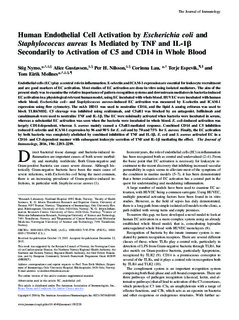| dc.contributor.author | Nymo, Stig Haugset | |
| dc.contributor.author | Gustavsen, Alice | |
| dc.contributor.author | Nilsson, Per | |
| dc.contributor.author | Lau, Corinna | |
| dc.contributor.author | Espevik, Terje | |
| dc.contributor.author | Mollnes, Tom Eirik | |
| dc.date.accessioned | 2017-05-18T08:39:00Z | |
| dc.date.available | 2017-05-18T08:39:00Z | |
| dc.date.created | 2016-07-13T15:03:22Z | |
| dc.date.issued | 2016 | |
| dc.identifier.citation | Journal of Immunology. 2016, 196 (5), 2293-2299. | nb_NO |
| dc.identifier.issn | 0022-1767 | |
| dc.identifier.uri | http://hdl.handle.net/11250/2442716 | |
| dc.description.abstract | Endothelial cells (EC) play a central role in inflammation. E-selectin and ICAM-1 expression are essential for leukocyte recruitmentand are good markers of EC activation. Most studies of EC activation are done in vitro using isolated mediators. The aim of thepresent study was to examine the relative importance of pattern recognition systems and downstream mediators in bacteria-inducedEC activation in a physiological relevant human model, using EC incubated with whole blood. HUVEC were incubated with humanwhole blood.Escherichia coli– andStaphylococcus aureus–induced EC activation was measured by E-selectin and ICAM-1expression using flow cytometry. The mAb 18D11 was used to neutralize CD14, and the lipid A analog eritoran was used toblock TLR4/MD2. C5 cleavage was inhibited using eculizumab, and C5aR1 was blocked by an antagonist. Infliximab andcanakinumab were used to neutralize TNF and IL-1b. The EC were minimally activated when bacteria were incubated in serum,whereas a substantial EC activation was seen when the bacteria were incubated in whole blood.E. coli–induced activation waslargely CD14-dependent, whereasS. aureusmainly caused a C5aR1-mediated response. Combined CD14 and C5 inhibitionreduced E-selectin and ICAM-1 expression by 96 and 98% forE. coliand by 70 and 75% forS. aureus.Finally, the EC activationby both bacteria was completely abolished by combined inhibition of TNF and IL-1b.E. coliandS. aureusactivated EC in aCD14- and C5-dependent manner with subsequent leukocyte secretion of TNF and IL-1bmediating the effect.The Journal ofImmunology, 2016, 196: 2293–2299. | nb_NO |
| dc.language.iso | eng | nb_NO |
| dc.publisher | American Association of Immunologists | nb_NO |
| dc.rights | Navngivelse-Ikkekommersiell 4.0 Internasjonal | * |
| dc.rights.uri | http://creativecommons.org/licenses/by-nc/4.0/deed.no | * |
| dc.title | Human endothelial cell activation by Escherichia coli and staphylococcus aureus is mediated by TNF and IL-1β secondarily to activation of C5 and CD14 in whole blood | nb_NO |
| dc.type | Journal article | nb_NO |
| dc.type | Peer reviewed | nb_NO |
| dc.source.pagenumber | 2293-2299 | nb_NO |
| dc.source.volume | 196 | nb_NO |
| dc.source.journal | Journal of Immunology | nb_NO |
| dc.source.issue | 5 | nb_NO |
| dc.identifier.doi | 10.4049/jimmunol.1502220 | |
| dc.identifier.cristin | 1367970 | |
| dc.relation.project | Norges forskningsråd: 223255 | nb_NO |
| dc.description.localcode | Copyright © 2016 by The American Association of Immunologists, Inc. This article is distributed under The American Association of Immunologists, Inc.,Reuse Terms and Conditions for Author Choice articles. | nb_NO |
| cristin.unitcode | 194,65,15,30 | |
| cristin.unitcode | 194,65,15,0 | |
| cristin.unitname | Centre of Molecular Inflammation Research (SFF-CEMIR) | |
| cristin.unitname | Institutt for kreftforskning og molekylær medisin | |
| cristin.ispublished | true | |
| cristin.fulltext | original | |
| cristin.qualitycode | 2 | |

